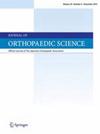Efficacy of radial shock wave therapy on rat models of adjuvant arthritis
IF 1.5
4区 医学
Q3 ORTHOPEDICS
引用次数: 0
Abstract
Background
Extracorporeal shock wave therapy (ESWT) is an effective treatment for musculoskeletal pain, tendinopathy, and fasciitis with an anti-inflammatory effect. ESWT can be categorized into two groups: radial pressure wave (RPW) and focused shock wave (FSW). Although there have been several studies on the inflammation and pain-improvement mechanisms of FSW, there are few studies on the pain-improvement mechanisms of RPW. This study aimed to elucidate the efficacy of RPW in a rat model of adjuvant arthritis.
Methods
Ninety-six rats were randomly categorized into three groups: RPW, control, and sham as follows: (I) RPW group, which received RPW application after complete Freund's adjuvant (CFA) injection; (II) Control group, which received only CFA injection; and (III) Sham group, which received only saline injection. All rats were evaluated at 0, 4, 7, 14, 28, and 56 days post-RPW application based on foot circumference, von Frey test, and immunohistochemistry of nerve fibers for calcitonin gene-related peptide (CGRP) and protein gene product (PGP) 9.5 in plantar skins.
Results
There were no significant differences in foot circumference between the RPW and control groups at any time point. The RPW group showed significant improvements in the von Frey test results on days 7 and 14. The total CGRP-immunoreactive (ir) and PGP9.5-ir nerve fiber lengths in the RPW group decreased on day 0; however, both were increased in the control group. The CGRP-ir and PGP9.5-ir nerve fibers in the RPW group were significantly shorter than those in the control group until day 14 after RPW.
Conclusions
RPW improved the mechanical hypersensitivity between days 7 and 14 after application. Like FSW, RPW also induced the degeneration of sensory nerve fibers in the skin in the early period after irradiation, and reinnervation occurred between 14 and 28 days. Thus, our results demonstrate one of the pain relief mechanisms after RPW application.
桡骨冲击波治疗对大鼠佐剂性关节炎模型的影响。
背景:体外冲击波疗法(ESWT)是治疗肌肉骨骼疼痛、肌腱病和筋膜炎的有效方法,具有抗炎作用。ESWT可分为径向压力波(RPW)和聚焦冲击波(FSW)两类。虽然已有一些关于FSW的炎症和疼痛改善机制的研究,但关于RPW的疼痛改善机制的研究很少。本研究旨在阐明RPW对佐剂性关节炎大鼠模型的疗效。方法:96只大鼠随机分为RPW组、对照组和假手术组,方法如下:(1)RPW组,在完全注射佛氏佐剂(CFA)后给予RPW;(II)对照组,仅注射CFA;(III)假手术组,只注射生理盐水。在rpw应用后0、4、7、14、28和56天,根据足底皮肤的足围、von Frey试验和神经纤维的免疫组化检测降钙素基因相关肽(CGRP)和蛋白基因产物(PGP) 9.5,对所有大鼠进行评估。结果:在任何时间点,RPW组与对照组的足围无显著差异。RPW组在第7天和第14天的von Frey试验结果有显著改善。RPW组总cgrp免疫反应性(ir)和PGP9.5-ir神经纤维长度在第0天减少;然而,在对照组中,两者都有所增加。直到第14天,RPW组的CGRP-ir和PGP9.5-ir神经纤维均明显短于对照组。结论:RPW在应用后7 ~ 14天改善了机械过敏。与FSW一样,RPW也在照射后早期诱导皮肤感觉神经纤维变性,并在14 ~ 28天出现神经再生。因此,我们的研究结果证明了RPW应用后疼痛缓解机制之一。
本文章由计算机程序翻译,如有差异,请以英文原文为准。
求助全文
约1分钟内获得全文
求助全文
来源期刊

Journal of Orthopaedic Science
医学-整形外科
CiteScore
3.00
自引率
0.00%
发文量
290
审稿时长
90 days
期刊介绍:
The Journal of Orthopaedic Science is the official peer-reviewed journal of the Japanese Orthopaedic Association. The journal publishes the latest researches and topical debates in all fields of clinical and experimental orthopaedics, including musculoskeletal medicine, sports medicine, locomotive syndrome, trauma, paediatrics, oncology and biomaterials, as well as basic researches.
 求助内容:
求助内容: 应助结果提醒方式:
应助结果提醒方式:


